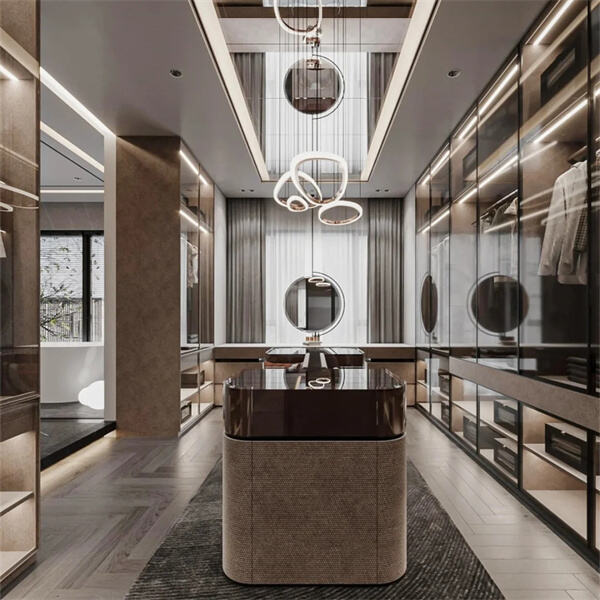ບັນຫາທົ່ວໄປໃດທີ່ຄວນຫຼີກລ່ຽງເມື່ອອອກແບບຫ້ອງເກັບເຄື່ອງແຕ່ງກາຍ
ຫ້ອງເກັບເຄື່ອງແຕ່ງກາຍບໍ່ແມ່ນພຽງແຕ່ເປັນພື້ນທີ່ເກັບຂອງ - ມັນເປັນພື້ນທີ່ສ່ວນຕົວທີ່ຄວາມເປັນລະບຽບຮຽນຮ້ອຍກັບຄວາມງາມ. ເຖິງຢ່າງໃດກໍຕາມ, ການອອກແບບໃຫ້ມີຄວາມສະດວກ, ຄວາມງາມ ແລະ ຄວາມເໝາະສົມນັ້ນຍາກກ່ວາທີ່ມັນເບິ່ງ. ບັນດາເຈົ້າຂອງເຮືອນມັກຈະຕົກເຂົ້າໃນຂໍ້ຜິດພາດທົ່ວໄປທີ່ເຮັດໃຫ້ຫ້ອງທີ່ພວກເຂົາຝັນໄວ້ກາຍເປັນພື້ນທີ່ທີ່ບໍ່ເປັນລະບຽບ ແລະ ບໍ່ມີປະສິດທິພາບ ຕູ້ເສື້ອຜ້າ ເຂົ້າໃນພື້ນທີ່ທີ່ບໍ່ເປັນລະບຽບ ແລະ ບໍ່ມີປະສິດທິພາບ. ຈາກການວາງແຜນພື້ນທີ່ບໍ່ດີ ຫາການຕິດຕັ້ງແສງສະຫວ່າງທີ່ຖືກເມີນ, ຂໍ້ຜິດພາດເຫຼົ່ານີ້ສາມາດເຮັດໃຫ້ຈຸດປະສົງຂອງຫ້ອງເກັບເຄື່ອງແຕ່ງກາຍບໍ່ສຳເລັດ. ່ມາເບິ່ງຂໍ້ຜິດພາດຕົ້ນຕໍທີ່ຄວນຫຼີກລ່ຽງ ແລະ ວິທີການສ້າງແບບອອກແບບທີ່ເໝາະສົມສຳລັບອະນາຄົດ.
ການເມີນການວາງແຜນພື້ນທີ່ ແລະ ການຈັດລະບຽບການສັນຈອນ
ໜຶ່ງໃນຄວາມຜິດພາດທີ່ໃຫຍ່ທີ່ສຸດໃນການອອກແບບຕູ້ເສື້ອເຂົ້າມຸມແມ່ນການລະເລີຍການວາງແຜນພື້ນທີ່, ໂດຍສະເພາະການຈັດຮຽນ. ຕູ້ເສື້ອເຂົ້າມຸມ ຄວນຮູ້ສຶກເປີດໂຕແລະງ່າຍຕໍ່ການສັນຈອນ, ແຕ່ການອອກແບບຫຼາຍອັນກໍເຮັດໃຫ້ມີພື້ນທີ່ເກັບຮັກສາຫຼວງຫຼາຍເກີນໄປ, ສົ່ງຜົນໃຫ້ທາງຍ່າງແຄບຫຼືບັອກການເຂົ້າເຖິງຊັ້ນວາງຂອງ. ຕົວຢ່າງ, ການວາງຕູ້ເສື້ອໃຫຍ່ກາງຫ້ອງອາດເບິ່ງຄືວ່າເປັນການໃຊ້ພື້ນທີ່ທີ່ດີ, ແຕ່ມັນອາດຈະສ້າງບັນຫາການຈະລາຈອນຕິດຂັດ, ເຮັດໃຫ້ຍາກຕໍ່ການເຂົ້າເຖິງຂອງທາງຝັ່ງກົງກັນຂ້າມ.
ເປັນຫຍັງມັນຈຶ່ງສຳຄັນ: ການຈັດຮຽນທີ່ແອອັດເຮັດໃຫ້ບໍ່ສາມາດໃຊ້ປະໂຫຍດຈາກ ຕູ້ເສື້ອເຂົ້າມຸມ . ຖ້າທ່ານພົບຄວາມຍາກຍາກໃນການຍ່າງລະຫວ່າງຊັ້ນວາງເສື້ອຜ້າ ຫຼືບໍ່ສາມາດເຂົ້າເຖິງຂອງໄດ້ໂດຍບໍ່ຕ້ອງຍ້າຍຂອງອື່ນໆອອກ, ພື້ນທີ່ດັ່ງກ່າວກໍຈະກາຍເປັນບັນຫາໃນການໃຊ້ງານປະຈຳວັນ. ໃນໄລຍະຍາວ, ສິ່ງນີ້ຈະເຮັດໃຫ້ເກີດຄວາມບໍ່ເປັນລະບຽບ, ເນື່ອງຈາກຂອງຕ່າງໆຖືກຍັດເຂົ້າໄປໃນບ່ອນທີ່ເຂົ້າເຖິງໄດ້ງ່າຍແທນທີ່ຈະເກັບໄວ້ໃນບ່ອນທີ່ກຳນົດໄວ້.
ວິທີຫຼີກລ່ຽງ: ຄວນໃຫ້ຄວາມສຳຄັນກັບເສັ້ນທາງທີ່ຈະແຈ້ງ. ພະຍາຍາມຮັກສາພື້ນທີ່ຫ່າງກັນຢ່າງໜ້ອຍ 30 ນິ້ວ (76 ຊມ) ລະຫວ່າງໜ່ວຍເກັບຮັກສາເພື່ອໃຫ້ຍ່າງໄດ້ສະດວກ. ຖ້າໂຊຟາມີປະຕູ, ຕ້ອງແນ່ໃຈວ່າປະຕູສາມາດເປີດໄດ້ທັງໝົດໂດຍບໍ່ໄປຂວາງຊັ້ນຫຼືແຂວນເສື້ອ. ສຳລັບຮູບແບບ U-shaped ຫຼື L-shaped, ຄວນຮັກສາພື້ນທີ່ກາງໃຫ້ຫ່າງຈາກເຟີນີເຈີຂະໜາດໃຫຍ່. ຕົວຢ່າງ, ໃນໂຊຟາທີ່ຂະໜາດ 10x12 ຟຸດ, ກຳນົດພື້ນທີ່ກາງ 4 ຟຸດສຳລັບການຍ່າງ, ແລະວາງໜ່ວຍເກັບຮັກສາຕາມຜະນັງ. ນີ້ຈະຊ່ວຍໃຫ້ເຂົ້າເຖິງທຸກພື້ນທີ່ໄດ້ຢ່າງສະດວກໂດຍບໍ່ຮູ້ສຶກອຶດອັດ.
ແສງສະຫວ່າງບໍ່ພຽງພໍ
ແສງສະຫວ່າງມັກຖືກເບິ່ງຂ້າມໃນການອອກແບບໂຊຟາ, ແຕ່ວ່າການມອງເຫັນທີ່ບໍ່ດີຈະເຮັດໃຫ້ຫາເຄື່ອງຍາກ, ບໍ່ສາມາດເລືອກສີເຄື່ອງນຸ່ງໄດ້ດີ, ຫຼືຮັກສາຄວາມເປັນລະບຽບ. ຮູບແບບຫຼາຍຮູບແບບອີງໃສ່ແຕ່ແສງໄຟເພດານດຽວ, ຊຶ່ງສ້າງເງົາໃນມຸມຫ້ອງ ຫຼືພາຍໃນຊັ້ນທີ່ເລິກເຊິ່ງເປັນບ່ອນທີ່ມັກຈະເກັບເກີບ, ອຸປະກອນເສີມ, ຫຼືເຄື່ອງນຸ່ງທີ່ພັບໄວ້.
ເປັນຫຍັງຈຶ່ງສໍາຄັນ: ຫ້ອງເກັບເຄື່ອງນຸ່ງທີ່ມືດຈະເຮັດໃຫ້ເກີດຄວາມຫົງເຫັນ. ທ່ານອາດຈະບໍ່ສາມາດເຫັນເຄື່ອງຂອງທີ່ຖືກເກັບໄວ້ໃນທີ່ມືດ, ຫຼືເສຍເວລາຊອກຫາຂອງພາຍໃນລິ້ນຊັກເນື່ອງຈາກບໍ່ສາມາດເບິ່ງເຫັນຂອງພາຍໃນໄດ້. ໃນບາງກໍລະນີຮ້າຍແຮງ, ການສະຫວ່າງບໍ່ພຽງພໍອາດຈະເຮັດໃຫ້ທ່ານບໍ່ສັງເກດເຫັນຄວາມເສຍຫາຍ ຫຼື ຈຸດດໍາເທິງເຄື່ອງນຸ່ງ.
ວິທີຫຼີກລ່ຽງບັນຫານີ້: ຕິດຕັ້ງແຫຼ່ງສະຫວ່າງໃນຫຼາຍຊັ້ນເພື່ອກໍາຈັດເງົາ. ສົມທົບການໃຊ້:
- ແຫຼ່ງສະຫວ່າງໂດຍລວມ: ແຫຼ່ງສະຫວ່າງຕິດເພດານແບບຍຸບເຂົ້າໄປພາຍໃນ ຫຼື ແຜງໄຟຕິດຕາມເສັ້ນທາງເພື່ອໃຫ້ສະຫວ່າງທົ່ວເນື້ອທີ່.
- ແຫຼ່ງສະຫວ່າງສໍາລັບການໃຊ້ງານเฉพาะ: ແຖບໄຟ LED ພາຍໃນຊັ້ນວາງຂອງ, ຂ້າງລຸ່ມຕູ້ເຄື່ອງ, ຫຼື ພາຍໃນລິ້ນເພື່ອສະຫວ່າງໃນບໍລິເວນສະເພາະ. ຕົວຢ່າງ, ການຕິດຕັ້ງແຖບໄຟຕາມຂອບຂອງຊັ້ນວາງເກີບຈະເຮັດໃຫ້ເບິ່ງເຫັນເກີບທຸກຄູ່ໄດ້ງ່າຍ.
- ແຫຼ່ງສະຫວ່າງເພື່ອເພີ່ມສະໄພ: ໄຟແຂວນ ຫຼື ໄຟຕິດຝາເພື່ອເພີ່ມຄວາມອົບອຸ່ນ ແລະ ລະດັບສະໄພ, ໂດຍສະເພາະໃນຫ້ອງເກັບເຄື່ອງນຸ່ງຂະໜາດໃຫຍ່.
-
ໄຟທີ່ມີເຊັນເຊີເຄື່ອນໄຫວເປັນທາງເລືອກອີກອັນໜຶ່ງທີ່ດີ - ມັນຈະຕິດອັດຕະໂນມັດເມື່ອທ່ານຍ່າງເຂົ້າໄປ, ບໍ່ຕ້ອງຍາກລໍາບາກຊອກຫາປຸ່ມສະວິດ. ສໍາລັບແຫຼ່ງສະຫວ່າງທໍາມະຊາດ, ຖ້າຫ້ອງເກັບເຄື່ອງມີປ່ອງຢ້ຽມ, ໃຊ້ມ່ານແພບາງເພື່ອໃຫ້ແສງສະຫວ່າງເຂົ້າມາໄດ້ໂດຍບໍ່ເຮັດໃຫ້ເຄື່ອງນຸ່ງເຊົ້າສີ.
ການບໍ່ສົນໃຈຄວາມຫຼາກຫຼາຍຂອງພື້ນທີ່ເກັບຮັກສາ
ຄວາມຜິດພາດທົ່ວໄປແມ່ນການອອກແບບຕູ້ເສື້ອບິນທີ່ມີພຽງຂະໜາດດຽວສໍາລັບທຸກຢ່າງ. ການຕິດຕັ້ງແຖບໂຍງເສື້ອແລະຊັ້ນຫນ້ອຍໆອາດເໝາະສໍາລັບບາງຄົນ, ແຕ່ມັນບໍ່ສາມາດຮອງຮັບເສື້ອຜ້າແຕ່ລະປະເພດ, ອຸປະກອນເສີມ, ຫຼືນິໄສສ່ວນຕົວໄດ້. ຕົວຢ່າງ, ຕູ້ເສື້ອທີ່ມີພຽງແຕ່ແຖບໂຍງຍາວຈະບໍ່ເໝາະສໍາລັບຄົນທີ່ມີເສື້ອສະເຟືອຍຫຼາຍຕົວ ຫຼື ມີເກັບເກີບຫຼາຍຄູ່.
ເປັນຫຍັງຈຶ່ງສໍາຄັນ: ພື້ນທີ່ເກັບຮັກສາທົ່ວໄປເຮັດໃຫ້ເສຍພື້ນທີ່. ສິ່ງຂອງໃຫຍ່ໆເຊັ່ນເສື້ອຄຸມຖືກອັດໄວ້ໃນບ່ອນແຄບ, ສິ່ງຂອງລະອຽດເຊັ່ນເຄື່ອງປະດັບຖືກພັນກັນ, ແລະເກີບຖືກເອົາມາວາງຊ້ອນກັນເຕັມພື້ນ. ໃນໄລຍະຍາວ, ຕູ້ເສື້ອຈະກາຍເປັນບ່ອນທີ່ບໍ່ເປັນລະບຽບ, ບໍ່ສາມາດໃຊ້ປະໂຫຍດໄດ້ຕາມຈຸດປະສົງ.
ວິທີຫຼີກລ່ຽງຄວາມຜິດພາດ: ປັບແຕ່ງພື້ນທີ່ເກັບຮັກສາໃຫ້ເໝາະກັບຄວາມຕ້ອງການຂອງທ່ານ. ລວມເອົາລາຍການຕໍ່ໄປນີ້:
- ທາງເລືອກໃນການໂຍງເສື້ອ: ແຖບໂຍງສອງຊັ້ນສໍາລັບເສື້ອເຊີື້ຕແລະເສື້ອບິນ (80-90 ຊັງຕີແມັດ), ແຖບຍາວສໍາລັບເສື້ອເຈັກເກີແລະເສື້ອຄຸມ (150-180 ຊັງຕີແມັດ), ແລະແຖບພິເສດສໍາລັບເນັກໄທ, ເຂັມຂັດເອີ້ນ, ຫຼືຜ້າພານໃຕ້ຄາງ.
- ຫຼັງຄາ: ເສື່ອຜ້າທີ່ສາມາດປັບໄດ້ເພື່ອໃສ່ເຄື່ອງທີ່ພັບໄວ້ (ເສື້ອຍືດ, ກະໂປຟັງ) ແລະ ຖັງທີ່ສາມາດຊ້ອນກັນໄດ້ສໍາລັບເຄື່ອງຕາມລະດູການ. ຫຼັງຄາທີ່ເຈາະ (30-45 ຊມ) ສາມາດໃຊ້ເກັບເກີບ ຫຼື ຖົງ, ໃນຂະນະທີ່ຫຼັງຄາຕື້ນ (15-20 ຊມ) ມີຄວາມເໝາະສົມສໍາລັບເຄື່ອງປະດັບ.
- ລິ້ນຊັກ: ລິ້ນຊັກທີ່ປິດຢ່າງນຸ້ມມືກັບຕົກແຕ່ງພາຍໃນສໍາລັບຖົງຕີນ, ກະໂປຟັງຍິງ ຫຼື ເຄື່ອງປະດັບ. ລິ້ນຊັກທີ່ສາມາດເລື່ອນໄດ້ດີກ່ວ່າລິ້ນຊັກທີ່ເລິກ - ທ່ານຈະບໍ່ຕ້ອງຄົ້ນຫາເພື່ອເອົາເຄື່ອງທີ່ຢູ່ດ້ານຫຼັງ.
- ບ່ອນເກັບມ້ຽນພິເສດ: ໂຕະເກັບເກີບ (ມຸມເອີ້ງເພື່ອໃຫ້ເຫັນໄດ້ຊັດ), ໂຮງງານເກັບຖົງ, ຫຼື ແຖບຍືດອອກເພື່ອວາງຜົນກະທົບ.
-

ຕົວຢ່າງ, ຜູ້ທີ່ມັກແຟຊັ່ນອາດຈະຕ້ອງການພື້ນທີ່ແຂວນເພີ່ມເຕີມ ແລະ ຝາເກັບເກີບທີ່ອຸທິດຕົນ, ໃນຂະນະທີ່ຄົນທີ່ມັກຄວາມງ່າຍອາດຈະໃຫ້ຄວາມສໍາຄັນກັບຫຼັງຄາ ແລະ ລິ້ນຊັກເພື່ອເກັບເຄື່ອງທີ່ພັບໄວ້.
ການເລືອກວັດສະດຸທີ່ຜິດ
ການເລືອກວັດຖຸດິບໃນຕູ້ເສື້ອຜ້າແມ່ນມີຄວາມສຳຄັນ, ແຕ່ຫຼາຍໆແບບອອກແບບໃຊ້ວັດຖຸດິບທີ່ບໍ່ເໝາະສົມ ຫຼື ລາຄາຖືກທີ່ສວມໃສ່ໄດ້ບໍ່ດີ ຫຼື ບໍ່ເຂົ້າກັນກັບການໃຊ້ງານ. ຂໍ້ຜິດພາດທົ່ວໄປລວມມີການໃຊ້ particleboard (ທີ່ບິດໂຄ້ງໃນສະພາບແວດລ້ອມທີ່ມີຄວາມຊຸ່ມ), ພື້ນຜິວເງົາທີ່ສະແດງຮ່ອງມື, ຫຼື ອຸປະກອນທີ່ບໍ່ແຂງແຮງທີ່ແຕກຫັກພາຍໃຕ້ພຽງນ້ຳຫນັກຫຼາຍ.
ເປັນຫຍັງຈຶ່ງສຳຄັນ: ວັດຖຸດິບທີ່ບໍ່ດີສົ້ນອາຍຸການໃຊ້ງານຂອງຕູ້ເສື້ອຜ້າ. ຊັ້ນ particleboard ອາດຈະຍຸບຕົວລົງພາຍໃຕ້ນ້ຳຫນັກຂອງເສື້ອຜ້າທີ່ພັບໄວ້, ໃນຂະນະທີ່ບານພັບທີ່ຖືກໆກ່ຽວກັບປະຕູອາດຈະມີສຽງດັງ ຫຼື ແຕກ, ເຮັດໃຫ້ພື້ນທີ່ຮູ້ສຶກບໍ່ດີ. ໃນສະພາບອາກາດທີ່ຊຸ່ມ, ໄມ້ທຳມະຊາດ ຫຼື MDF ທີ່ບໍ່ໄດ້ປິ່ນປົວສາມາດເກີດເຊື້ອເຫັດໄດ້, ເຊິ່ງເຮັດໃຫ້ເສື້ອຜ້າເສຍຫາຍ.
ວິທີຫຼີກລ່ຽງ: ເລືອກວັດຖຸດິບທີ່ມີຄວາມຍືນຍົງ ແລະ ຕ້ານທານຄວາມຊຸ່ມຊື່ນ.
- ຊັ້ນວາງຂອງ: ໄມ້ແຜ່ນຫຼືໄມ້ແຂງ (ປິ່ນປົວເພື່ອຕ້ານທານຄວາມຊຸ່ມຊື່ນ) ເພື່ອໃຫ້ໄດ້ຄວາມເຂັ້ມແຂງ. ສຳລັບທາງເລືອກທີ່ຖືກກ່ວາ, MDF ທີ່ມີຊັ້ນປົກຫຸ້ມ laminate ສາມາດໃຊ້ໄດ້, ແຕ່ຫຼີກລ່ຽງໃນຫ້ອງນ້ຳ ຫຼື ພື້ນທີ່ຊັ້ນລຸ່ມທີ່ມີຄວາມຊຸ່ມ.
- ອຸປະກອນເຊັ່ນ: ບານພັບແລະສະລັອດຕິງທີ່ແຂງແຮງ (ຮັບນ້ຳໜັກຢ່າງໜ້ອຍ 50 ປອນ) ເພື່ອຮັບມືກັບການນຳໃຊ້ປະຈຳວັນ. ລະບົບປິດຊ້າ (Soft-close) ປ້ອງກັນບໍ່ໃຫ້ປິດແຮງແລະຫຼຸດຜ່ອນຄວາມເສຍຫາຍ.
- ສີສຳເລັດຮູບ: ສີດຳມັນ (Matte) ຫຼື ສີດຳມັນປະເພດຊາຍ (satin) ຈະຊ່ອນຮ່ອງນິ້ວມືໄດ້ດີກ່ວາສີເງົາ. ສຳລັບພື້ນເຮືອນ, ຕົວເລືອກທີ່ກັນນ້ຳໄດ້ດີເຊັ່ນ: ພື້ນໄມ້ສັງເຄາະ (LVP) ຫຼື ພື້ນໄມ້ແຂງທີ່ຖືກປິດຜິວດ້ານ, ສາມາດເຊັດເຮັດຄວາມສະອາດໄດ້ງ່າຍເວລາເຄື່ອງນຸ່ງຫຼືອຸປະກອນຕົກລົງມາ.
-
ຖ້າຫ້ອງເກັບເຄື່ອງຢູ່ໃກ້ກັບຫ້ອງນ້ຳ, ຄວນເພີ່ມເຄື່ອງດູດຊື້ນ (dehumidifier) ຫຼື ສິ່ງກີດຂວາງຄວາມຊື້ນຢູ່ດ້ານຫຼັງຂອງຜະນັງເພື່ອປ້ອງກັນວັດສະດຸແລະເຄື່ອງນຸ່ງ.
ລະເລີຍຄວາມຍືດຫຍຸ່ນຕໍ່ຄວາມຕ້ອງການທີ່ປ່ຽນແປງ
ຫ້ອງເຄື່ອງນຸ່ງຄວນປັບຕົວຕາມການປ່ຽນແປງຂອງຊີວິດ - ວ່າທ່ານຈະເລີ່ມສ້າງຄອບຄົວ, ຍ້າຍໄປເຮັດວຽກຢູ່ເຮືອນ, ຫຼື ພັດທະນາສິ່ງທີ່ມັກໃໝ່. ແຕ່ຫຼາຍໆການອອກແບບມີຄວາມແຂງກະດ້າງ, ມີຊັ້ນວາງຂອງທີ່ຖືກຕັ້ງໄວ້ແລ້ວ ຫຼື ກຳແພງແບ່ງທີ່ບໍ່ສາມາດປັບໄດ້. ຕົວຢ່າງ, ຫ້ອງເຄື່ອງນຸ່ງທີ່ຖືກອອກແບບສຳລັບຄົນຄົນດຽວອາດບໍ່ພຽງພໍເມື່ອຄູ່ສົມລົດເຂົ້າຢູ່ຮ່ວມ, ຫຼື ຄວາມສູງຂອງແຂ້ວວາງເຄື່ອງນຸ່ງທີ່ຖືກຕັ້ງໄວ້ອາດບໍ່ເໝາະສົມເມື່ອຮູບແບບເຄື່ອງນຸ່ງຂອງທ່ານປ່ຽນ (ເຊັ່ນ: ຈາກເຄື່ອງນຸ່ງຍາວເປັນເສື້ອສູດ).
ເປັນຫຍັງຈຶ່ງສຳຄັນ: ການອອກແບບທີ່ແຂງກະດ້າງຈະກາຍເປັນບໍ່ທັນສະໄໝຢ່າງໄວວາ. ທ່ານອາດຈະສິ້ນເຊີງດ້ວຍພື້ນທີ່ທີ່ບໍ່ໄດ້ໃຊ້ປະໂຫຍດ, ຫຼື ຖືກບັງຄັບໃຫ້ປັບປຸງກ່ອນທີ່ຄາດຄະເນໄວ້, ເພີ່ມຄ່າໃຊ້ຈ່າຍທີ່ບໍ່ຈຳເປັນ.
ວິທີຫຼີກລ່ຽງ: ສຳເລັດຄວາມຍືດຫຍຸ່ນ. ເລືອກ:
- ຊັ້ນວາງຂອງປັບໄດ້: ສາມາດຍ້າຍຂຶ້ນ-ລົງໄດ້ເພື່ອຮັບສິ່ງຂອງທີ່ສູງກ່ວາ (ເຊັ່ນ: ເກີບບູດ) ຫຼື ສັ້ນກ່ວາ (ເຊັ່ນ: ເສື້ອຍືດພັບ).
- ລະບົບແບບມີຄວາມຍືດຫຍຸ່ນ: ໜ່ວຍທີ່ຕັ້ງເອງ ຫຼື ຕິດກັບຜະນັງທີ່ສາມາດຈັດລຽງໃໝ່ ຫຼື ຂະຫຍາຍໄດ້. ຕົວຢ່າງ, ການເພີ່ມຊັ້ນວາງຂອງໃໝ່ ຫຼື ແຂ້ວວາງເກີບທີ່ສາມາດເຮັດໄດ້ງ່າຍດ້ວຍການອອກແບບແບບມີຄວາມຍືດຫຍຸ່ນ.
- ຄຸນນະສົມບັດຫຼາຍຢ່າງ: ເຊັ່ນ ແຜ່ນຮີດເສື້ອທີ່ພັບລົງໄດ້, ຕູ້ເກັບຂອງທີ່ຊ້ອນໄດ້, ຫຼື ກະຈົກທີ່ສາມາດດຶງອອກມາໃຊ້ເປັນແຕ່ງໜ້າໄດ້. ສິ່ງເຫຼົ່ານີ້ສາມາດປັບຕົວຕາມຄວາມຕ້ອງການທີ່ແປງປວນໄດ້, ຈາກການໃຊ້ງານປະຈຳວັນຈົນເຖິງການກຽມເດີນທາງ.
-
ຕົວຢ່າງເຊັ່ນ ບຸກຄົນອາຊີບໜຸ່ມສາວອາດອອກແບບຕູ້ເກັບເຄື່ອງນຸ່ງຂອງຕົນດ້ວຍທໍ່ແລະ ຊັ້ນວາງຂອງທີ່ສາມາດປັບໄດ້, ໂດຍຮູ້ວ່າພວກເຂົາສາມາດປັບປຸງມັນໃໝ່ໄດ້ພາຍໃນ 5 ປີເມື່ອເຄື່ອງນຸ່ງເພີ່ມຂຶ້ນ.
ການອອກແບບທີ່ເກີນຈຳເປັນ: ການສູນເສຍຄວາມສະດວກສະບາຍເພື່ອຄວາມງາມ
ມັນງ່າຍທີ່ຈະຕິດໃຈກັບການອອກແບບທີ່ທັນສະໄໝ - ຄິດເຖິງກຳແພງທີ່ບຸກະຈົກຕັ້ງແຕ່ພື້ນຈົນເພດານ, ແຊນເດີເລຍ, ຫຼື ຕູ້ປະຕູແກ້ວ - ແຕ່ການອອກແບບທີ່ເກີນຈຳເປັນສາມາດເຮັດໃຫ້ການໃຊ້ງານເສຍຫາຍ. ກຳແພງກະຈົກອາດເຮັດໃຫ້ພື້ນທີ່ຮູ້ສຶກກ້ວາງຂຶ້ນ, ແຕ່ມັນກໍສະທ້ອນໃຫ້ເຫັນທຸກໆສິ່ງທີ່ເປື້ອນຫຼື ວຸ້ນວາຍ. ຕູ້ປະຕູແກ້ວເບິ່ງແລ້ວທຳມະດາແຕ່ຕ້ອງການຄວາມສະອາດຕະຫຼອດເວລາເພື່ອບໍ່ໃຫ້ມີຂີ້ຝຸ່ນຢູ່ເທິງສິ່ງຂອງທີ່ວາງສະແດງ.
ເຫດຜົນສຳຄັນ: ຄວາມງາມຄວນເສີມຂະຫຍາຍການໃຊ້ງານ, ບໍ່ແມ່ນຂັດຂວາງ. ຕູ້ເກັບເຄື່ອງນຸ່ງທີ່ຕົກແຕ່ງດ້ວຍອຸປະກອນທີ່ຮັກສາຄວາມງາມຕ້ອງໃຊ້ຄວາມພະຍາຍາມຫຼາຍກາຍເປັນວຽກທີ່ຍາກໃນການຮັກສາ, ນຳໄປສູ່ການປະຖິ້ມແລະການບໍ່ເປັນລະບຽບ.
ວິທີຫຼີກລ່ຽງ: ສົມດຸນລະຫວ່າງຄວາມງາມແລະຄວາມສະດວກ.
- ແຜ່ນຈຳພາບ: ເລືອກໃຊ້ແຜ່ນຈຳພາບທີ່ມີຄວາມສູງຕະຫຼອດເຖິງປະຕູໜຶ່ງແທນທີ່ຈະປົກຄຸມທຸກໆຝາ - ນີ້ຈະຊ່ວຍຫຼຸດຜ່ອນການເຊັດຖູໃນຂະນະທີ່ຍັງຮັກສາຈຸດປະສົງໄວ້.
- ການວາງສະແດງ vs. ການເກັບຮັກສາທີ່ຊ່ອນໄວ້: ໃຊ້ປະຕູແກ້ວຢ່າງຈຳກັດ (ຕົວຢ່າງ, ສຳລັບສິ່ງຂອງໃນໂອກາດພິເສດ) ແລະ ຮັກສາເຄື່ອງນຸ່ງທີ່ໃຊ້ປະຈຳວັນໄວ້ເບື້ອງຫຼັງປະຕູແບບທຶບຫຼື ມ່ານເພື່ອຊ່ອນຄວາມລຳຄານ.
- ແສງສະຫວ່າງ: ຫຼີກເວັ້ນອຸປະກອນປະດັບທີ່ສັບສົນເກີນໄປ (ເຊັ່ນ: ແຟນເພດານ) ທີ່ສະສົມເອົາຂີ້ຝຸ່ນ; ຍັງຄົງໃສ່ການສະຫວ່າງທີ່ໃຊ້ງານໄດ້ດີ ແລະ ສະອາດງ່າຍ.
-
ຈື່ໄວ້: ການອອກແບບຕູ້ເຄື່ອງແຕ່ງຕົວທີ່ດີທີ່ສຸດໃຫ້ຄວາມສຳຄັນຕໍ່ການໃຊ້ງານປະຈຳວັນຫຼາຍກ່ວາຮູບລັກສະນະໃນຮູບຖ່າຍ.
FAQ: ການອອກແບບຕູ້ເຄື່ອງແຕ່ງຕົວ
ຂະໜາດຂັ້ນຕ່ຳສຳລັບຕູ້ເຄື່ອງແຕ່ງຕົວແມ່ນຫຍັງ?
ຕູ້ເຄື່ອງແຕ່ງຕົວຕ້ອງການພື້ນທີ່ຢ່າງໜ້ອຍ 5x7 ແຜນ (1.5x2.1 ແມັດ) ເພື່ອໃຫ້ຮູ້ສຶກວ່າສາມາດໃຊ້ງານໄດ້. ນີ້ອະນຸຍາດໃຫ້ມີທາງຍ່າງ 30 ນິ້ວ ແລະ ພື້ນທີ່ເກັບຮັກສາເຄື່ອງ 2 ຂ້າງຝາ. ພື້ນທີ່ນ້ອຍກ່ວານັ້ນ (4x6 ແຜນ) ອາດຍັງສາມາດໃຊ້ໄດ້ແຕ່ຕ້ອງວາງແຜນຢ່າງລະມັດລະວັງ (ຕົວຢ່າງ, ຊັ້ນວາງຂອງແຄບ, ປະຕູເລື່ອນ).
ຂ້ອຍຈະເພີ່ມພື້ນທີ່ເກັບຮັກສາໃນຕູ້ເຄື່ອງແຕ່ງຕົວຂະໜາດນ້ອຍໄດ້ແນວໃດ?
ໃຊ້ພື້ນທີ່ຕັ້ງແຕ່ພື້ນຈົນເຖິງເພດານ: ຕິດຕັ້ງຊັ້ນຫຼືແຖບໂຄ້ງ. ເພີ່ມຕົກແຂວນເທິງປະຕູສໍາລັບເຂັມຂັດ, ຜ້າພອມ, ຫຼືເສື້ອຄຸມ. ໃຊ້ຕົກແຂວນແຄບເພື່ອປົດປ່ອຍພື້ນທີ່ແຖບໂຄ້ງ, ແລະເລືອກຊັ້ນ/ລິ້ນຊັກແບບດຶງອອກເພື່ອຫຼີກເວັ້ນການສູນເສຍພື້ນທີ່ໃນເຊິ່ງເລິກ ຕູ້ ພື້ນທີ່.
ຂ້ອຍຄວນຈ້າງນັກອອກແບບມືອາຊີບສໍາລັບຫ້ອງເກັບເຄື່ອງຂອງຂ້ອຍບໍ?
ຂຶ້ນຢູ່ກັບຄວາມຊັບຊ້ອນ. ສໍາລັບຮູບແບບທີ່ງ່າຍໆ, ການອອກແບບດ້ວຍຕົນເອງດ້ວຍລະບົບແບບມົດຟູນັ້ນເໝາະສົມ. ສໍາລັບພື້ນທີ່ໃຫຍ່, ຮູບຊົງທີ່ບໍ່ປົກກະຕິ, ຫຼືຄຸນສົມບັດແບບສັ່ງເຮັດພິເສດ (ຕົວຢ່າງ, ໂຕະແຕ່ງໜ້າບິນ) ນັກອອກແບບມືອາຊີບສາມາດຊ່ວຍໃນການຈັດການໄຫຼວຽນແລະຫຼີກເວັ້ນຄວາມຜິດພາດດ້ານໂຄງສ້າງ.
ວິທີທີ່ດີທີ່ສຸດໃນການຈັດການຫ້ອງເກັບເຄື່ອງແມ່ນຫຍັງ?
ຈັດກຸ່ມສິ່ງຂອງຕາມປະເພດ (ຕົວຢ່າງ, ຊຸດເສື້ອເຊີິດທັງໝົດ, ລົງໃນກ່ອງ/ລິ້ນຊັກດຽວກັນ). ເກັບສິ່ງທີ່ໃຊ້ເປັນປະຈໍາໃນລະດັບຕາ; ເກັບສິ່ງຂອງຕາມລະດູການ (ຕົວຢ່າງ, ເສື້ອຄຸມໜາວ) ໄວ້ໃນຊັ້ນເທິງສູງ ຫຼືໃນກ່ອງເກັບຂອງໃຕ້ຕຽງ.
ການລົມໃນຫ້ອງເກັບເຄື່ອງມີຄວາມສໍາຄັນຫຼາຍປານໃດ?
ສຳຄັນຫຼາຍ. ການລົມບໍ່ດີຈະເຮັດໃຫ້ເກີດກິ່ນອັບ, ຂີ້ເຜິ້ງ, ແລະ ຜ້າເສື່ອເສຍຫາຍ. ຖ້າຕູ້ເສື້ອເປັນແບບປິດ, ຄວນເພີ່ມປະຕູລົມ, ພັດລົມໄລຍະ, ຫຼື ຊ່ອງລົມນ້ອຍໆເພື່ອໃຫ້ລົມຖ່າຍເຊື້ອ. ເຄື່ອງດູດຊື້ນຊ່ວຍໄດ້ໃນສະພາບອາກາດທີ່ມີຄວາມຊຸ່ມຊື້ນ.

